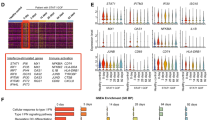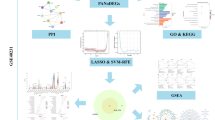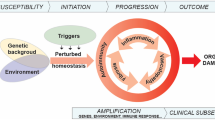Abstract
The aim of this study was to explore the anti-psoriatic effect and potential mechanism of Angelica polysaccharide (APS) on an in vitro HaCaT cell model. MTS assay was performed to determine whether APS has the ability to inhibit the proliferation of HaCaT cells. RNA-sequencing (RNA-seq) was performed to investigate the underlying mechanism of APS. Quantitative real-time PCR (qRT-PCR) was used to verify the accuracy of RNA-seq data. Our MTS assay results demonstrated that APS time- and concentration-dependently inhibits the proliferation of HaCaT cells. The anti-proliferation property of APS suggests that APS may have anti-psoriatic effect. In the RNA-seq part, comparison between the CK group (i.e., Control group) and ASP groups revealed dramatic differences [468 differentially expressed genes (DEGs) for CK group vs. ASP50 group; 563 DEGs for CK group vs. ASP100 group; 532 DEGs for CK group vs. ASP200 group]. Gene Ontology (GO) and Kyoto Encyclopedia of Genes and Genomes (KEGG) enrich analysis performed on all DEGs failed to find any significant enriched GO terms or KEGG pathways to explain the anti-proliferative effect of APS. All DEGs were then classified into 20 expression profiles by trend analysis. Interestingly, cell proliferation-related GO terms were mostly dispersed in the profile 2 and 17. DEGs enriched in these terms were then analyzed. After literature retrieval, DEGs such as SERPINE1, SMAD6, CTGF, and TGF-β were suspected to closely relevant to the anti-proliferation effect of APS. qRT-PCR results showed similar expression trend with RNA-seq data for 8 out of 10 genes, indicating our sequence data are reliable.




Similar content being viewed by others
References
Chunshui Y, Yunzhu M, Jiangwei S, Fen X, Xiaojie D, Yan C, Xing C (2010) Experimental study of angelica polysaccharide induced apoptosis on HaCaT Cells. Chin J Dermato Venerol Integ Trad W Med 9(3):143–145
Di Fusco D, Laudisi F, Dinallo V, Monteleone I, Di Grazia A, Marafini I, Troncone E, Colantoni A, Ortenzi A, Stolfi C (2017) Smad7 positively regulates keratinocyte proliferation in psoriasis. Brit J Dermatol 177(6):1633–1643
Endo H, Momota Y, Oikawa A, Shinkai H (2006) Psoriatic skin expresses the transcription factor Gli1: possible contribution of decreased neurofibromin expression. Brit J Dermatol 154(4):619–623
Farahnik B, Sharma D, Alban J, Sivamani R (2017) Oral (systemic) botanical agents for the treatment of psoriasis: a review. J Altern Complement Med 23(6):418–425
Hayakawa K, Ikeda K, Fujishiro M, Yoshida Y, Hirai T, Tsushima H, Miyashita T, Morimoto S, Suga Y, Takamori K (2018) Connective tissue growth factor neutralization aggravates the psoriasis skin lesion: the analysis of psoriasis model mice and patients. Ann Dermatol 30(1):47–53
Huang X, Lei Y, Guan H, Hao Y, Liu H, Sun G, Chen R, Song S (2017) Transcriptomic analysis of the regulation of stalk development in flowering Chinese cabbage (Brassica campestris) by RNA sequencing. Sci Rep UK 7(1):15517
Huang T-H, Lin C-F, Alalaiwe A, Yang S-C, Fang J-Y (2019) Apoptotic or antiproliferative activity of natural products against keratinocytes for the treatment of psoriasis. Int J Mol Sci 20(10):2558
Jiang M, Sun Z, Dang E, Li B, Fang H, Li J, Gao L, Zhang K, Wang G (2017) TGFβ/SMAD/microRNA-486-3p signaling axis mediates keratin 17 expression and keratinocyte hyperproliferation in psoriasis. J Invest Dermatol 137(10):2177–2186
Jing H, Sheng W (2006) Influence of angelica polysaccharide on apoptosis in keratinocytes of psoriasis-like lesions of guinea pigs. Med J Wuhan Univ 3(27):377–379
Jing H, Sheng W, Duan D (2008) The influence of angelica polysaccharide on the expression levels of PCNA in psoriasis-like lesions of guinea pigs. Chin J Dermatovenereol 22(1):11–13
Keseroglu HO, Gönül M (2014) Traditional topical herbal therapies in psoriasis. TANG 4(4):13–20
Kushwaha A (2017) A review on alternative treatment of Psoriasis. J Pharm Res 11(7):864–877
Li X-L, Wang Z-H, Zhao Y-X, Luo S-J, Zhang D-W, Xiao S-X, Peng Z-H (2012) Purification of a polysaccharide from Gynostemma pentaphyllum Makino and its therapeutic advantages for psoriasis. Carbohyd Polym 89(4):1232–1237
Li N, Zhao W, Xing J, Liu J, Zhang G, Zhang Y, Li Y, Liu W, Shi F, Bai Y (2017) Chinese herbal Pulian ointment in treating psoriasis vulgaris of blood-heat syndrome: a multi-center, double-blind, randomized, placebo-controlled trial. Bmc Complem Altern M 17(1):264
Liang W, Lin Z, Zhang L, Qin X, Zhang Y, Sun L (2017) Calcipotriol inhibits proliferation of human keratinocytes by downregulating STAT1 and STAT3 signaling. J Invest Med 65(2):376–381
Man X, Chen X, Li W, Landeck L, Dou T, Chen J, Zhou J, Cai S, Zheng M (2015) Analysis of epithelial–mesenchymal transition markers in psoriatic epidermal keratinocytes. Open Biol 5(8):1–8
Nielsen HJ, Christensen IJ, Svendsen M, Hansen U, Werther K, Brünner N, Petersen L, Kristensen J (2002) Elevated plasma levels of vascular endothelial growth factor and plasminogen activator inhibitor-1 decrease during improvement of psoriasis. Inflamm Res 51(11):563–567
Ota T, Takekoshi S, Takagi T, Kitatani K, Toriumi K, Kojima T, Kato M, Ikoma N, Mabuchi T, Ozawa A (2014) Notch signaling may be involved in the abnormal differentiation of epidermal keratinocytes in psoriasis. Acta Histochem Cytoc 47(4):175–183
Qu XA, Freudenberg JM, Sanseau P, Rajpal DK (2014) Integrative clinical transcriptomics analyses for new therapeutic intervention strategies: a psoriasis case study. Drug Discov Today 19(9):1364–1371
Saito A, Suzuki HI, Horie M, Ohshima M, Morishita Y, Abiko Y, Nagase T (2013) An integrated expression profiling reveals target genes of TGF-β and TNF-α possibly mediated by microRNAs in lung cancer cells. PLoS One 8(2):e56587
Sobolev V, Zolotorenko A, Soboleva A, Elkin A, Il’ina S, Serov D, Potekaev N, Tkachenko S, Minnibaev M, Piruzyan A (2011) Effects of expression of transcriptional factor AP-1 FOSL1 gene on psoriatic process. B Exp Biol Med 150(5):632–634
Tse W-P, Che C-T, Liu K, Lin Z-X (2006) Evaluation of the anti-proliferative properties of selected psoriasis-treating Chinese medicines on cultured HaCaT cells. J Ethnopharmacol 108(1):133–141
Wang J, Chen G, Shi T, Wang Y, Guan C (2019) Possible treatment for cutaneous lichen planus: an in vitro anti-inflammatory role of Angelica polysaccharide in human keratinocytes HaCaT. Int J Immunopathol Pharmacol 33:2058738418821837
Weng S, Chen B, Wang Y, Liu C, Sun M, Chang C, Lin J, Yen H (2016) Traditional Chinese medicine use among patients with psoriasis in Taiwan: a nationwide population-based study. Evid Based Compl Alt 2:1–13
Wu P, Ma G, Zhu X, Gu T, Zhang J, Sun Y, Xu H, Huo R, Wang B, Shen B (2017) Cyr61/CCN1 is involved in the pathogenesis of psoriasis vulgaris via promoting IL-8 production by keratinocytes in a JNK/NF-κB pathway. Clin Immunol 174:53–62
Yu H, Mrowietz U, Seifert O (2009) Downregulation of SMAD2, 4 and 6 mRNA and TGFβ receptor I mRNA in lesional and non-lesional psoriatic skin. Acta Derm Venereol 89(4):351–356
Zhang CS, Yu JJ, Parker S, Zhang AL, May B, Lu C, Xue CC (2014) Oral Chinese herbal medicine combined with pharmacotherapy for psoriasis vulgaris: a systematic review. Int J Dermatol 53(11):1305–1318
Zhang C, Xu Q, Tan X, Meng L, Wei G, Liu Y, Zhang C (2017) Astilbin decreases proliferation and improves differentiation in hacat keratinocytes. Biomed Pharmacother 93:713–720
Acknowledgements
This work was supported by grants from the Project of Sichuan Science and Technology Bureau (2016JY0214), the Scientific Research Project of Sichuan Health and Family Planning Commission (150243) and the Scientific Research Project of Suining Municipality (2015S23).
Author information
Authors and Affiliations
Corresponding author
Ethics declarations
Conflict of interest
The author declares that they have no competing interests.
Electronic supplementary material
Below is the link to the electronic supplementary material.
13205_2019_1828_MOESM1_ESM.xlsx
Supplement table S1. All DEGs after APS treatment as compared with the CK group. Genes with log2(FC)>1 and FDR<0.05 were up-regulated; Genes with log2(FC) <-1 and FDR<0.05 were down-regulated. (XLSX 182 kb)
Rights and permissions
About this article
Cite this article
Yu, C., Liu, L., Liao, Q. et al. Transcriptomic profiles of human HaCaT cells in response to angelica polysaccharide. 3 Biotech 9, 301 (2019). https://doi.org/10.1007/s13205-019-1828-z
Received:
Accepted:
Published:
DOI: https://doi.org/10.1007/s13205-019-1828-z




